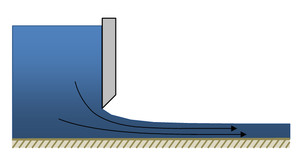HY8:Vena Contracta: Difference between revisions
m (Jcreer moved page HY-8:Vena Contracta to HY8:Vena Contracta) |
No edit summary |
||
| Line 1: | Line 1: | ||
== What is it? == | == What is it? == | ||
When water is forced through | When water is forced through an orifice opening, like a sluice gate, the water continues to decrease in depth as the streamline curves turn to follow the direction of travel. The location of the smallest cross-sectional area of flow is called the Vena Contracta. At the point of the Vena Contracta, the streamlines are first parallel. | ||
[[Image:VenaContractaDiagram.png|300px]] | [[Image:VenaContractaDiagram.png|300px]] | ||
| Line 7: | Line 7: | ||
== When and where does it occur in culvert hydraulics? == | == When and where does it occur in culvert hydraulics? == | ||
The Vena Contracta occurs at the inlet of a culvert whenever the inlet control depth is greater than the outlet control depth. These conditions are created when the tailwater is low and the culvert is short. | The Vena Contracta occurs at the inlet of a culvert whenever the inlet control depth is greater than the outlet control depth. These conditions are created when the tailwater is low and the culvert is short. | ||
== How does HY-8 handle those computations? == | == How does HY-8 handle those computations? == | ||
HY-8 neglects the Vena Contracta except when the culvert slope is horizontal or adverse | HY-8 neglects the Vena Contracta except when the culvert is under inlet control and the slope is horizontal or adverse. | ||
HY-8 will use the following equation to determine the length of the Vena Contracta: | HY-8 will use the following equation to determine the length of the Vena Contracta: | ||
| Line 28: | Line 28: | ||
Where: | Where: | ||
*d<sub>vc</sub> = Vena Contracta Final Depth | *d<sub>vc</sub> = Vena Contracta Final Depth | ||
*c = Vena Contracta Coefficient | *c = Vena Contracta Coefficient; Hy-8 uses 0.8 for box shaped culverts and 0.7 for the remaining shapes | ||
*y<sub>inlet</sub> = Headwater Depth or Rise of the Culvert, whichever is smaller | *y<sub>inlet</sub> = Headwater Depth or Rise of the Culvert, whichever is smaller | ||
Revision as of 17:47, 28 February 2018
What is it?
When water is forced through an orifice opening, like a sluice gate, the water continues to decrease in depth as the streamline curves turn to follow the direction of travel. The location of the smallest cross-sectional area of flow is called the Vena Contracta. At the point of the Vena Contracta, the streamlines are first parallel.
When and where does it occur in culvert hydraulics?
The Vena Contracta occurs at the inlet of a culvert whenever the inlet control depth is greater than the outlet control depth. These conditions are created when the tailwater is low and the culvert is short.
How does HY-8 handle those computations?
HY-8 neglects the Vena Contracta except when the culvert is under inlet control and the slope is horizontal or adverse.
HY-8 will use the following equation to determine the length of the Vena Contracta:
Where:
- L = Vena Contracta Length
- D = Rise of Culvert
HY-8 uses the following equation to determine the final depth of the Vena Contracta:
Where:
- dvc = Vena Contracta Final Depth
- c = Vena Contracta Coefficient; Hy-8 uses 0.8 for box shaped culverts and 0.7 for the remaining shapes
- yinlet = Headwater Depth or Rise of the Culvert, whichever is smaller
